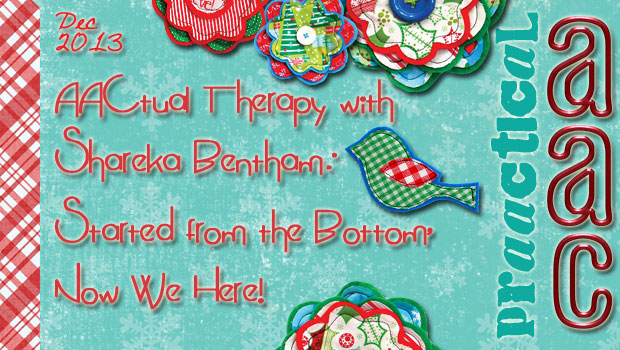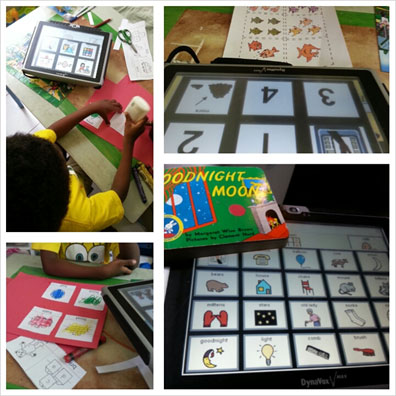AACtual Therapy with Shareka Bentham: Started from the Bottom, Now We Here!

We’re so thrilled to have Shareka Bentham back as an AACtual Therapist, this time talking about her journey into high tech AAC. You can see other posts from Shareka here. One of our colleagues completed the AAC evaluation on a client of Shareka’s. While preparations for that evaluation were underway, we were fortunate enough to learn of an AAC device that was no longer needed. The family agreed to donate it to this little fellow, and that seems to have launched a whole chain of prAACtical events. Shareka takes it from here…
One of our colleagues completed the AAC evaluation on a client of Shareka’s. While preparations for that evaluation were underway, we were fortunate enough to learn of an AAC device that was no longer needed. The family agreed to donate it to this little fellow, and that seems to have launched a whole chain of prAACtical events. Shareka takes it from here…
Sadly, this is not the first step into my career as a rapping superstar, but more a description of my journey from ‘no tech’ to high tech in AAC use.
If someone had told me a year ago that I would be showing off my skills on a high tech AAC device, and teaching children, parents, and teachers how to use this tool for a range of communicative functions, I would have laughed in disbelief. The truth is that I was just as hesitant to transition to high tech AAC use, as I had initially been to start using basic AAC in my practice. I had created this (erroneous) mindset that it would be way too complicated to learn, I wouldn’t be able to teach it effectively, and so many other excuses, which I placed as imaginary obstacles on my journey.
Over the past couple years, I moved from communication books/boards to switch devices, to more advanced devices such as the Attainment GoTalk 4+ and 9+ and the AbleNet Quicktalker 12 with a range of clients (Note that I still continue to use all of these with various clients depending on their level and need). However, some of my more advanced/tech savvy little ones were showing that they had skills past what these devices could offer, they needed more options, wanted to say more, wanted a greater challenge. I realized that at this point I, as a therapist, was proving to be the obstacle for them, as my fears were holding them back from moving past these skills.
A bit of intervention happened when one of my clients was given a Dynavox Vmax+ device following recommendation from his AAC assessment. I was, in a sense, forced to learn everything about it so we could use it in sessions, and so I could in turn teach him, family, and teachers how to use it. I took a few webinars and just played around with the device, which was the best way to learn how to navigate the pages, understand the various displays, and fall in love with the device. By the following week I had ordered my own (second hand, of course)!
One thing I really like about the Dynavox is that it uses the same PCS (Boardmaker) symbols which I use for all devices and visuals in my clinic, so no need to learn new symbols for the words already known.
I’d like to share some of the ways which I have been using high tech AAC with some of my clients.
My 4 year old client who owns the device is quite verbal, but still can be unintelligible due to dysarthria from his truncal hypotonia. He also has impaired limb/digit movement and uses the keyguard to help with the precision of his message selection. His goals for his device have been to clarify some of his messages when his communication partner does not understand; to use longer sentences to respond to comprehension questions from stories; to complete his spelling tests at school (love the print function for that), and to play turntaking games such as ‘Go Fish’ and ‘Guess Who.”
My 6 year old client has ASD and is nonverbal, but he is very tech savvy. He has learnt to use the visual scene displays to navigate his classroom and make requests, fill in stories, participate in circle time activities, and complete his work. His favourite activity is the art corner, as he likes cutting and sticking, so we work on requesting glue, scissors, and paper to make pictures. He has also learnt to say he needs a break, navigate to another area on his dynamic display and select a toy to play with.
My 8 year old client is also nonverbal, and has made an amazing transition to high tech AAC. She can now engage in very basic conversations, construct sentences to describe pictures, complete spelling activities, and read stories. Her page navigation skills are improving, and we are now working on using the device more spontaneously within the classroom setting to make requests.
I am by no means an expert in high tech AAC, but I am definitely more skilled in its use, and continue to learn more with daily use of the device. I’m quite eager now to explore more of these high tech tools to see which ones may best fit my clients’ needs. I love the flexibility which the devices provide, especially the fact that I can create a new page, or introduce new vocabulary on the spot, as it presents itself within the session.
My name is Shareka, and I’m now a high tech AAC addict!
Filed under: PrAACtical Thinking
This post was written by Carole Zangari
